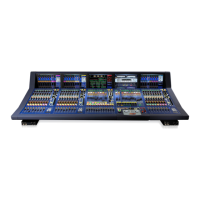313
XL8 Control Centre
Operator Manual
Hz: Symbol for “Hertz”. A unit of frequency
equal to one cycle of a sound wave per second.
I zone: Area on the output bay that contains
the operator-assignable effects controls.
I/O: Abbreviation for “input/output”.
Ident: Scale marking, or gradation, around a
control knob to help indicate the current setting
and to assist in accurate adjustment.
ID: Abbreviation for “identification”.
Impedance (Z): Opposition to the flow of
alternating current in a circuit, measured in
ohms.
Input: 1. The signal being received by a device.
2. The physical location of where a device
receives a signal.
Input bay: Control area for input and,
optionally, return (aux input) paths.
Input channel strip: Control area in input bay
for fast access to primary input functions.
Input fast strip: One of eight strips in the input
fast zone that provides detailed control of a
single channel’s input functions.
Input fast zone: Control area in the input bay
for detailed control of input functions.
Input navigation zone: Area in input bay for
GUI screen navigation and control, and input
channel selection.
k: Kilo- prefix symbol that represents 10
3
or one
thousand, for example, kHz (one thousand Hz)
or km (one thousand metres).
LCD: Abbreviation for “liquid crystal display”.
LCR: Abbreviation for “left-centre-right”,
referring to speakers.
LED: Abbreviation for “light emitting diode”.
LF: Abbreviation for “low frequency”.
Limiter: An extreme form of compressor that
only affects signals above a selected threshold
level (dB).
Main bus: A type of bus; see Bus.
Output bay: Control area for main output and
(part support) for sub mix paths.
Output fast zone: Control area for fast access
to primary main output functions.
Level: General term for volume or amplitude.
LPF: Abbreviation for “low pass filter”. A filter
that removes higher frequencies from a signal,
leaving the lower frequencies unaffected.
m: 1. Prefix symbol for “metre(s)”, for example,
as in “200 m” (200 metres); please note the
intermediate space. 2. Prefix symbol for milli-,
which represents 10
-3
or one thousandth, for
example, as in “2ms” (2 milliseconds); there is
no intermediate space.
MADI: Abbreviation for “multi-channel audio
digital interface”. An AES standard for digital
interconnection between multi-track recorders
and mixing consoles.
Matrix mix master: One of two channels in an
output fast strip for control of the matrix mix.
Master overview strip: One of three channels
in the output fast zone for stereo (left and right)
and mono masters.
Meter: Visual device to indicate the level of a
signal.
Mic: Abbreviation for “microphone”.
Microphone: Device for converting sound
waves into audio signals.
MIDI: Acronym for “musical instrument digital
interface”. A digital signal system standard that
facilitates integration of musical instruments,
such as synthesizers and guitars, with
computers.
Mix: 1. A signal that contains a combination of
signals, such as a pair of stereo signals with
numerous effects. 2. The act of creating such a
combination. 3. A type of bus; see Bus.
Mix bay: Control area for sub mix and (part
support) for main output paths.
Mix fast strip: One of eight dual-channel strips
in the mix fast zone for detailed control of the
aux mixes.
Mix fast zone: Area on the mix bay for
auxiliary (aux) mix masters.
Mixer: 1. A console or other device that blends
input signals into composite signals for output.
2. An engineer/technician who carries this out,
especially during a live performance.
mm: Symbol for “millimetre” (one thousandth
of a metre).
MON: Abbreviation for “monitor”, used to
describe a control centre being used to mix the
signals sent to the stage monitor speakers.
Monitor: 1. Speaker(s) used for listening to a
mix or live audio. 2. The act of listening to a
mix or live audio.
Monitor A: Primary monitor bus system.
Monitor B: Secondary monitor bus system.
Monitors: Control area on the output bay for
monitoring the A and B signal paths.
Mono: A single signal.

